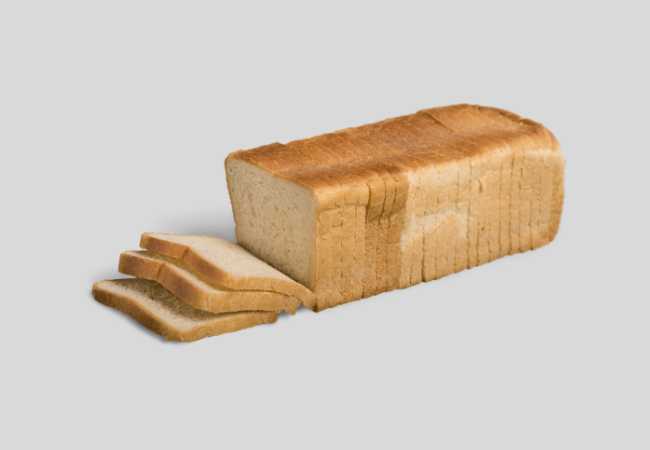White bread is a pantry staple, but the refined carbs and calories can add up fast if you’re not careful with portions. In this article, we’ll explore how many calories in one slice of white bread. You might be surprised at the calorie range between different types and sizes of bread. We’ll also look at the nutritional profile and health impact of white bread, plus smarter ways to enjoy it as part of a healthy diet.
Table of Contents
What is White Bread?
White bread is made from refined wheat flour which has had the bran and germ removed during processing. This results in a light colored bread with soft texture, mild flavor, and extended shelf life. Common varieties include basic sandwich bread, baguettes, brioche, and challah. White bread contains carbohydrates in the form of starch and limited amounts of protein, fat, and nutrients. It is typically enriched with added vitamins and minerals. The simple carbs and lack of fiber cause it to be digested and absorbed quickly.
How Many Calories in One Slice of White Bread?
One slice of commercial white sandwich bread contains anywhere from 60-120 calories, depending on the brand and exact slice size. Thick, bakery-style white bread or artisan loaves range from 100-150 calories per slice. Some factors that influence calorie count include:
– Ingredients like added fats, sweeteners, and enriching agents
– Density and water content – airy bread has fewer calories than dense
– Slice size – jumbo slices have more calories than thin sliced
Check out: Nutrition Facts About a Slice of White Bread
Understanding Serving Size Matters
Pay close attention to serving sizes listed on nutrition labels, as “one slice” can vary significantly. A small slice may be 30-40 grams while a very large bakery slice could be 100+ grams, essentially double the calories. Measure your typical slice to determine its true calorie count. Also be mindful that uses like sandwiches and toast often involve consuming multiple slices.
Related: How Many Calories Are In Spring Mix?
Comparing Calories in Different White Breads
Here are calorie counts for popular types of commercial white bread:
– Basic white sandwich bread: 60-80 calories per thin slice
– Hearty white bread: 80-100 calories per regular slice
– Texas toast: 140-150 calories per extra thick slice
– White baguette: Around 100 calories per 3-inch piece
– Bakery Italian or French bread: 100-200 calories per thick slice
Factors Impacting white bread calories Count
Factors like added fats and sweeteners impact white bread calories:
– Bread made with oil or butter is higher calorie than no fat versions
– Sweetened bread contains more calories than unsweetened
– Heavily enriched white bread tends to have more calories than unenriched
– Dense artisan breads have more calories than light sandwich breads
How Calories Add Up for Sandwiches and Toast
White bread is commonly used for sandwiches, toast, croutons, and other dishes requiring multiple slices. Two slices of bread for a sandwich can total 120-240 calories before fillings. Toasting boosts calories slightly by drying out the bread. Be cautious of large servings of dishes made with white bread piling on extra calories beyond just one slice.
Nutritional Profile Beyond Calories
Aside from calories, white bread offers little nutritional value. A slice provides 15-20 grams of carbohydrate, mostly from refined starch. Fiber content is low at about 1 gram per slice. White bread is not a significant source of protein, healthy fat, vitamins or minerals beyond some added enrichment. Whole grain bread offers more nutrition benefits.
Health Impact of White Bread Consumption
The refined grains in white bread cause rapid spikes in blood sugar when eaten, which can be problematic for diabetes risk and management. The lack of fiber provides little satiety, leading to potential overeating. While an occasional slice of white toast or sandwich bread is fine, regularly relying on refined white bread in place of whole grains is associated with increased risk for obesity, heart disease, and certain cancers.
Smarter Ways to Enjoy White Bread
You can still enjoy white bread in moderation as part of a healthy diet with these strategies:
– Pair bread with protein, healthy fats and veggies for balanced nutrition
– Look for sprouted grain or sourdough versions with lower glycemic impact
– Opt for thin sandwich slices instead of thick bakery breads
– Use just one slice or half a baguette or roll
– Choose whole grains like whole wheat pita or rye for sandwiches
Related: How Many Calories Are In A Chef Salad?
Lower Calorie Alternatives to White Bread
If cutting calories is your priority, consider these lower carb swap-ins:
– Lettuce or collard green wraps instead of bread slices
– Low-carb tortillas or lavash bread – 40-80 calories per large wrap
– Rice cakes or crispbreads for mini open-faced sandwiches
– Salad or zucchini noodles instead of pasta in recipes
White Bread in a Weight Loss Diet
White bread can be incorporated into a weight loss diet in moderate amounts. Just be sure to account for the 60-120 calories per slice in your daily calorie budget. Focus on proper portion sizes of one slice or less, and balance sandwiches or other dishes made with white bread with lean proteins, veggies and healthy fats. For maximum nutrients and satiety, emphasize whole grain breads. But the occasional white bread treat is perfectly fine.
A Word From Blogzah
One slice of white bread contains 60-120 calories, depending on exact type, brand, and size. Baguettes, bakery breads, and thick toast slices can range up to 150-200 calories per serving. Pay close attention to portion sizes, and limit white bread as an overall percentage of your grain intake to control calories. Combine with protein, healthy fats and veggies for balanced nutrition.
















